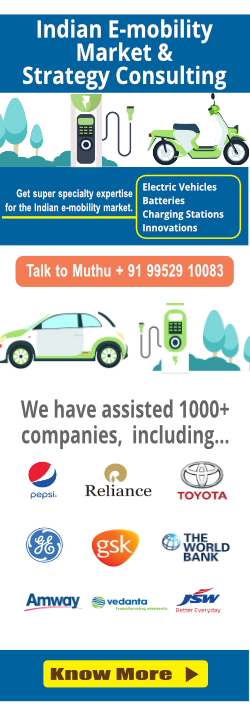Last Updated: February 2020 by Narasimhan Santhanam
This pos![]() t is a part of EV Next’s EV Perspectives.
t is a part of EV Next’s EV Perspectives.
EV Next, a division of EAI, is a leading market intelligence & strategic consulting firm for the Indian e-mobility sector.
Get to know about 1000+ EV innovations from EVI2: Electric Vehicle Innovation Intelligence from EVNext
For anyone designing a growth strategy for EVs, it is important to understand the following about challenges:
- Challenge over Time – How will the challenges trend over time? Are the challenges of a short term nature that will become insignificant in a short time (say, within a year or two)? Or are these challenges that will take a decade or more to be mitigated?
- Alternatives – Are these challenges rigid or flexible? That is, is it possible that these challenges could be mitigated to a significant extent through the use of some alternatives?
- Control over Challenge – Finally, what is the extent of control that the Indian government or industry has over these challenges?
Inputs on the above aspects are provided for the key challenges to EV growth.
| Category | Challenge | Analysis |
|
Cost |
|
|
|
Performance |
|
|
|
|
The following points stand out from the above table:
- To a large extent, the challenges are technology-based, revolving around batteries and battery charging. The exception is the EV charging infrastructure, which is more of a cost and infrastructural challenge than a technology challenge.
- Neither the technology challenges nor the infrastructural challenges can be resolved in the short term.
- Battery technologies for faster charging and higher ranges are likely to take until 2023.
- Li-ion batteries will take perhaps until about 2026 for enough cost reduction to make EVs reach cost parity with conventional vehicles.
- Extensive rollout of EV charging infrastructure to cover inter-city highways and smaller cities and towns will be infeasible in the short term (2-3 years).
- While high cost is a rigid constraint (unless one considers external incentives as an alternative), there are alternatives for low range and high charging time challenges, in the form of optimal charging infrastructure and battery swapping business models. However, both these alternatives have technical, operational or economic challenges on their own. An “optimal” combination of these alternatives will hence be needed to maximize value and minimize costs.
Some other Challenges are:
- Power paradox – there will be demand for power but this constraint is not very serious as India’s demand for power is roughly 175 GW. While the power to be generated for charging of vehicles is still under question, any country that intends to run a large fleet of EVs will have to depend on electricity provided by a smart electricity grid
- Power source– EV projects stand or fall on the reliability of the power supply
- The cost of an electric bus is huge. So how are we expecting to bring changes in public transport?
- There is no clear-cut EV policy in place
- Lack of customer awareness
- The government should provide strong incentives on upfront EV purchase
- Lack of lithium deposits in the country
- Delay in subsidies and weak EV infrastructure needs to be addressed
The number of electric and hybrid vehicles sold during 2015-16 was very small – just about 1.1% nationally of the total vehicle share and 4.1% in Delhi.
The sales in Delhi might have been spurred by the Delhi government’s Air Ambience Fund – an accumulation of pollution cess of 25 paise on every liter of diesel sold in the city. The fund is being used to subsidize electric vehicles of all categories.
Learn more on various Status & Trends in E-Mobility across: Indian EV Prices | Global EV Market | Indian EV Market | Current status of Indian EV Market | Indian Vehicle Segments | International Startups Takeaways | Indian Startups takeaways |
![]() Know more on how EV Next can assist your business in your strategy for the e-mobility and electric vehicles sectors, Here
Know more on how EV Next can assist your business in your strategy for the e-mobility and electric vehicles sectors, Here
Wish to know everything about India’s EV market from one place? Check out the India EV Expert Guide, an 800 page comprehensive guide to the Indian EV market. Here
Get to know about 1000+ EV innovations from EVI2: Electric Vehicle Innovation Intelligence from EVNext
See also the blog posts:
- Strategy for Indian Electric Vehicle Growth – Product, Tech, Infra Strategies for EV Market
- India EV Strategy & Trends in Indian Transport and Energy Ecosystem – MRTS, BS VI, Biofuels…
- Current and Future Market Sizes of Electric Vehicles – Global EV Growth
Comprehensive Inputs on Indian EV Ecosystem
Check out the following sections for comprehensive inputs on Indian EV ecosystem (click on each section for more details)



 Retaining Great Talent in Fast-Growing Startups: Illumine Industries’ Approach
Retaining Great Talent in Fast-Growing Startups: Illumine Industries’ Approach




